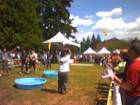If you’re not into discovering mind shattering classical recordings you may want to skip this post.
Okay, now that everyone but my family has stopped reading: A few weeks ago I did something unusual—I bought a few CDs. Since the advent of online music purchases the physical article has seemed unnecessary, but what the hey, I was waiting for the Sears across the street to replace Lisa’s tires and I had nothing better to do. I listened to the Big Star disc and liked it a lot, but forgot about one of the others until yesterday, when I played it—and got crazy excited.
On the surface the disc is nothing special: an unfamiliar label budget two-disc set called “Music of the Gothic Era.” When I looked at the liner notes, though, I started realizing I had hit gold. The conductor, David Munrow, had revolutionized early music in the late 60s and the 70s by hiring top notch musicians, particularly vocalists, who were able to bring top performance quality to these ancient (in some cases 800 year old) works and make them sound like music to modern ears. And the group? Well, I had never heard of the Early Music Consort of London, but I had heard of some of the vocalists, among whom were David James, Rogers Covey-Crump, Paul Elliott, and John Potter. These are guys who were also in a little group called the Hilliard Ensemble—still one of the superstar groups of early music for their vocal performances which are so astounding they’re almost superhuman. And this recording has them before the Hilliard Ensemble took off, covering some of the same material for which the Hilliard Ensemble later became famous, under a director who had very different ideas about performance.
Very different. If this were a Hilliard Ensemble disc, it would probably have been recorded only with voices in accordance with modern understanding of medieval performance practices. Instead, in the pieces attributed to Léonin (the legendary founder of the Notre Dame school of sacred music, in which for the first time in documented history chant was augmented with harmony), the voices are accompanied by bells. In some of the anonymous fourteenth century motets (including a recording of “Alle, psallite cum luya,” which I sang as a Christmas processional—and sometime drinking song—with the Virginia Glee Club), a shawm and tabor are added. Other pieces have lute, fiddle, portative organ, and slide trumpet. But regardless of the amount of extra baggage added, the sound of the voices is still thrilling, bringing this ancient music alive.
Music of the Gothic Era stays my “Current Listening” today as I work my way through Disc 2. It’s definitely recommended—a two-disc overview of some of the most unusual and rewarding vocal music around.

